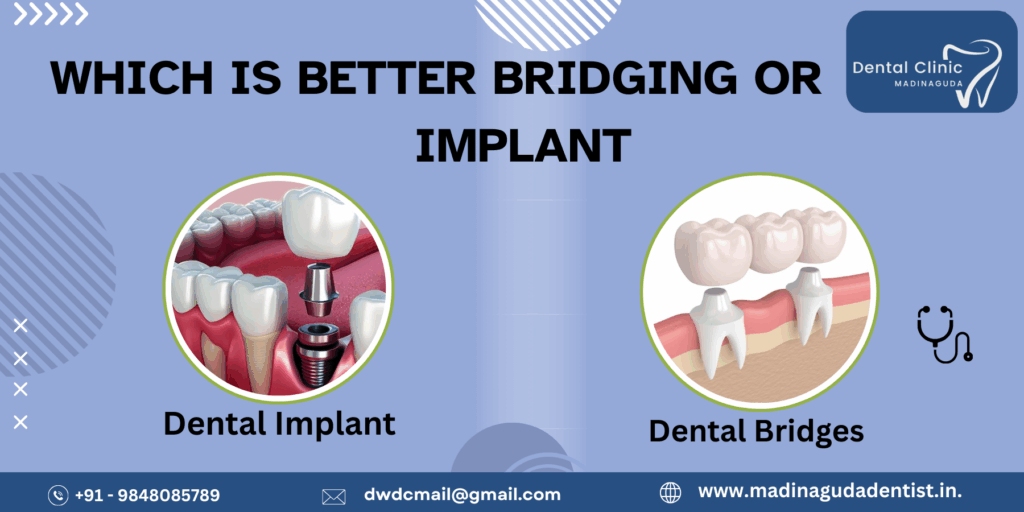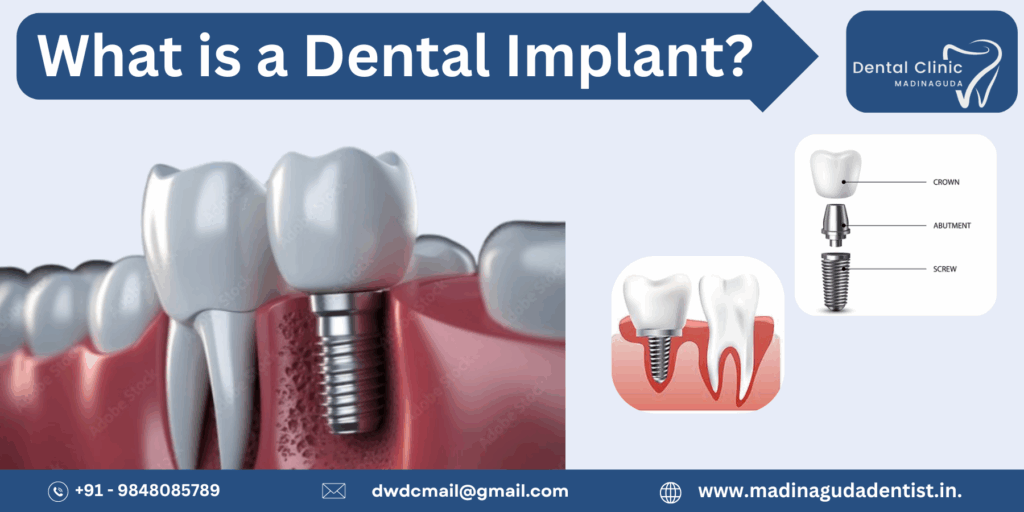Which is Better Bridging or Implant

Introduction
When a tooth is lost, the empty space left behind can lead to several complications:
Tooth loss is a common dental issue that can happen due to various reasons, such as tooth decay, gum disease, injury, or natural aging. While it may seem like just an aesthetic concern, the reality is that missing teeth can significantly impact both oral health and overall well-being.
- Shifting of Adjacent Teeth:
Neighboring teeth tend to drift towards the gap, causing misalignment and bite issues over time. This can make everyday activities like chewing and speaking more challenging. - Bone Loss (Jawbone Resorption):
The jawbone relies on stimulation from tooth roots to maintain its density and strength. When a tooth is missing, that area of the bone begins to deteriorate, which can lead to facial sagging and further tooth loss. - Gum Health Issues:
Gaps from missing teeth create spaces where food particles and plaque can easily accumulate, increasing the risk of gum infections and periodontal disease. - Impaired Chewing Ability:
Missing teeth make it harder to chew food properly, limiting diet choices and potentially leading to nutritional deficiencies. Over time, this strain on remaining teeth can accelerate wear and tear. - Speech Difficulties:
Teeth play an essential role in pronouncing certain sounds. Gaps, especially in the front teeth, can lead to speech difficulties like lisping or slurred pronunciation. - Self-Esteem and Confidence Impact:
Beyond the physical effects, missing teeth can affect a person’s confidence and willingness to smile or engage socially, impacting both personal and professional interactions.
What is a Dental Bridge?

A dental bridge is a fixed dental restoration used to replace one or more missing teeth by literally “bridging” the gap between the remaining natural teeth. The bridge is made up of two main components:
1.Abutment Teeth: These are the natural teeth (or dental implants) on either side of the gap that provide support for the bridge.
2.Pontic (Artificial Tooth): This is the false tooth or teeth that fill the empty space. The pontic is typically made from durable materials like porcelain, ceramic, gold, or metal alloys and is designed to look and function like natural teeth.
How Does a Dental Bridge Work?
The bridge is anchored to the abutment teeth, which are either covered with dental crowns (if natural teeth are used) or secured to dental implants. The artificial tooth or teeth in between are suspended over the gap, creating a seamless line of teeth.
Purpose of Dental Bridges
Dental bridges serve several important purposes:
- Restoring Functionality: Bridges allow you to chew and speak properly, which can be compromised with missing teeth.
- Maintaining Facial Structure: Missing teeth can cause the facial muscles to sag, giving an older appearance. Bridges help maintain facial structure and prevent sunken cheeks.
- Preventing Shifting of Teeth: When there’s a gap, surrounding teeth tend to drift into the empty space, leading to misalignment. A bridge keeps your teeth in their correct positions.
- Distributing Bite Forces: The bridge evenly distributes the forces of your bite, reducing stress on the surrounding teeth.
- Enhancing Aesthetics and Confidence: A well-constructed bridge looks natural, restoring your smile and boosting self-confidence.
Benefits of Dental Bridges
Restores your natural smile and facial appearance.
- Improves chewing ability and comfort.
- Prevents nearby teeth from shifting out of place.
- Maintains the natural shape of your face.
- Requires fewer visits compared to implants.
- More affordable than dental implants.
Types of Dental Bridges
There are four main types of dental bridges, each designed for specific situations based on the location of the missing tooth and the condition of the surrounding teeth. Let’s explore each one:
1. Traditional Dental Bridge
- This is the most common type of bridge.
- It consists of a false tooth (pontic) held in place by dental crowns cemented onto the adjacent natural teeth (abutments).
- To place a traditional bridge, the abutment teeth must be filed down to fit the crowns, even if they are healthy.
Ideal For:
- Filling gaps with natural teeth on both sides of the missing tooth.
Pros:
- Strong and durable—can withstand powerful chewing forces.
- Aesthetic match to natural teeth.
Cons:
- Requires removal of some healthy tooth enamel from the abutments.
Permanent, irreversible alteration to the supporting teeth.
2. Cantilever Dental Bridge
- This type of bridge is used when there is only one natural tooth next to the gap.
- The bridge is anchored on just one abutment tooth rather than two.
Ideal For:
- Areas with less chewing pressure, such as front teeth.
Pros:
- Requires only one healthy tooth for support.
- Less invasive than traditional bridges.
Cons:
- Puts extra stress on the single abutment tooth, potentially leading to damage.
Not recommended for back molars due to bite pressure.
3. Maryland Dental Bridge (Resin-Bonded Bridge)
- Also known as a resin-bonded bridge, this type uses a metal or porcelain framework bonded to the back of adjacent teeth instead of crowns.
- It involves minimal alteration to the neighboring teeth.
Ideal For:
- Replacing front teeth where the bite pressure is lower.
Pros:
- Less invasive—no need to file down healthy teeth.
- More affordable than traditional bridges.
Cons:
- Not as strong or durable as traditional bridges.
- Metal wings may sometimes affect the natural appearance of teeth.
4. Implant-Supported Dental Bridge
- This bridge is anchored by dental implants instead of natural teeth.
- It is typically used when multiple teeth are missing in a row.
- One implant is placed for every missing tooth, or a bridge is supported by two or more implants.
Ideal For:
- Large gaps where many teeth are missing.
- Long-term solution with maximum stability.
Pros:
- Strongest and most durable bridge type.
- Prevents bone loss by stimulating the jawbone.
- Does not require alteration of neighboring teeth.
Cons:
- Requires surgery for implant placement.
- Higher initial cost compared to other bridge types.
- Longer healing time due to implant integration.
- Requires surgery for implant placement.
What is a Dental Implant?

Overview of Dental Implants and Their Structure
A dental implant is an artificial tooth root.
It is surgically placed into the jawbone to replace a missing tooth.
The implant provides a strong foundation for a replacement tooth or bridge.
It is designed to look, feel, and function like a natural tooth.
Structure of a Dental Implant
1. Implant Fixture (Post):
- This is the screw-like part that goes into the jawbone.
- Made from titanium or zirconia.
- It serves as the root of the new tooth.
- The material is biocompatible, so the body accepts it naturally.
2. Abutment:
- A connector piece placed on top of the implant.
- It links the implant fixture to the crown.
- Usually made of titanium, gold, or porcelain.
- It extends slightly above the gum line.
3. Crown (Prosthetic Tooth):
- The visible part of the dental implant.
- Custom-made to match the color and shape of your natural teeth.
- Crafted from porcelain or ceramic for a realistic appearance.
Designed to handle normal chewing and biting.
How Does a Dental Implant Work?
- The implant fixture is surgically placed in the jawbone.
- Over time, it fuses with the bone through a process called osseointegration.
- An abutment is attached to the implant after healing.
- Finally, the crown is placed on top to restore function and appearance.
Benefits of Dental Implants:
- Long-lasting and durable solution.
- Prevents bone loss and maintains facial structure.
- Natural look and feel, just like real teeth.
- Does not require altering neighboring teeth.
- Improves chewing and speech abilities.
Types of Dental Implants
There are three main types of dental implants based on their placement and structure: Endosteal, Subperiosteal, and Zygomatic implants. Each type is designed for specific conditions and jawbone health. Let’s explore each one:
1. Endosteal Implants
- Endosteal implants are the most common type of dental implant.
- They are surgically placed directly into the jawbone.
- Shaped like small screws or cylinders, typically made of titanium.
- Over time, they fuse with the jawbone through a process called osseointegration.
Structure:
- Includes a post (implant fixture), abutment, and a crown.
- The implant acts as the root, while the abutment connects it to the crown.
Ideal For:
- Patients with healthy jawbone density.
- Those looking for a long-term, durable solution.
Advantages:
- Strong and stable, allowing for normal chewing and biting.
- Long-lasting with proper care—can last a lifetime.
Limitations:
- Requires sufficient jawbone height and strength.
- Additional procedures like bone grafting may be needed if bone density is low.
2. Subperiosteal Implants
- Subperiosteal implants are placed under the gum but above the jawbone.
- Instead of being drilled into the bone, they rest on top of the bone.
- A metal frame is fitted under the gum, and posts extend through the gums to hold the prosthetic tooth.
Structure:
- Consists of a metal frame with attached posts.
- The gums heal around the frame, securing it in place.
Ideal For:
- Patients with insufficient jawbone height who cannot undergo bone grafting.
- Those who prefer a less invasive option.
Advantages:
- No need for extensive bone reconstruction.
- Faster healing compared to endosteal implants.
Limitations:
- Less stable than endosteal implants.
- Not as commonly used due to modern advancements in bone grafting.
3. Zygomatic Implants
- Zygomatic implants are the least common type and the most complex.
- They are placed in the zygoma (cheekbone) rather than the jawbone.
- Typically used when there is severe bone loss in the upper jaw.
Structure:
- Much longer than traditional implants.
- Anchored in the cheekbone instead of the maxilla (upper jawbone).
Ideal For:
- Patients with extensive bone loss who cannot support endosteal or subperiosteal implants.
- Cases where bone grafting is not possible or desired.
Advantages:
- Eliminates the need for bone grafting.
- Provides a solid foundation even with major jawbone loss.
Limitations:
- More invasive surgical procedure.
- Requires a highly skilled specialist for proper placement.
Procedure Comparison: Bridge vs. Implant
Below is a step-by-step breakdown of the procedure for Dental Bridges and Dental Implants presented in a clear box model for easy comparison:
Step | Dental Bridge | Dental Implant |
1. Initial Consultation | Dentist examines oral health, discusses options, and takes X-rays and impressions. | Dentist evaluates jawbone density, overall health, and takes detailed X-rays. |
2. Tooth Preparation | Adjacent teeth (abutments) are filed down to fit dental crowns. | No tooth preparation required. The focus is on the implant site. |
3. Impressions Taken | Molds of your teeth are taken to create a custom bridge. | Digital or traditional impressions are made for custom implant design. |
4. Temporary Bridge (if needed) | A temporary bridge is placed while the permanent one is being crafted. | In some cases, a temporary crown is placed over the implant site. |
5. Bridge Placement | The permanent bridge is cemented onto the abutment teeth. | Implant post is surgically placed into the jawbone. |
6. Healing Time | Very minimal—bridge is functional as soon as it’s placed. | Takes 3 to 6 months for the implant to osseointegrate with the bone. |
7. Abutment Placement | Already part of the bridge structure—no separate step required. | After healing, an abutment is attached to the implant post. |
8. Crown or Bridge Fitting | The bridge (with crowns and pontic) is adjusted and cemented for a secure fit. | A custom-made crown is secured onto the abutment. |
9. Final Adjustments | Minor adjustments may be made for comfort and bite alignment. | Dentist checks alignment and bite for perfect fitting. |
10. Follow-up Care | Regular check-ups for cleaning and maintenance. | Regular visits to monitor integration and gum health. |
Cost Comparison: Dental Bridge vs. Dental Implant
Aspect | Dental Bridge | Dental Implant |
Average Cost (INR) | ₹8,000 – ₹60,000+ | ₹20,000 – ₹1,50,000+ |
Cost per Tooth | ₹8,000 – ₹20,000 | ₹20,000 – ₹80,000+ |
Material Options | Porcelain-fused-to-metal (PFM), Zirconia | Titanium, Zirconia |
Longevity | 5–15 years | 15–25+ years |
Bone Preservation | Does not prevent bone loss | Stimulates and preserves jawbone |
Aesthetic Appeal | Moderate to High (depends on material) | High (especially with zirconia crowns) |
Procedure Duration | 1–2 weeks | 3–6 months (including healing time) |
Impact on Adjacent Teeth | Requires alteration of neighboring teeth | No impact on adjacent teeth |
Suitability | Ideal when adjacent teeth need crowns | Best for patients with sufficient jawbone density |
Additional Procedures | Rarely needed | May require bone grafting or sinus lift, adding ₹5,000 – ₹20,000 |
Insurance Coverage | Often covered | Coverage varies; check with provider |
Advantages and Disadvantages of Dental Implants
Advantages of Dental Implants | Disadvantages of Dental Implants |
Natural Look and Feel: Implants look and function like natural teeth. | Higher Cost: More expensive than bridges or dentures. |
Long-lasting Durability: Can last 15–25+ years with proper care. | Longer Treatment Time: Healing and osseointegration take 3–6 months. |
Prevents Bone Loss: Stimulates the jawbone, preventing bone deterioration. | Surgical Procedure Required: Involves surgery, which may not be suitable for everyone. |
No Impact on Adjacent Teeth: Does not require filing down neighboring teeth. | Risk of Complications: Possibility of infection or implant failure. |
Improved Chewing and Speech: Restores bite force, enhancing eating and speaking. | Not Suitable for All: Requires sufficient bone density; bone grafting may be needed. |
Low Maintenance: Functions like a natural tooth with regular brushing and flossing. | Extended Recovery Time: Healing process is longer compared to bridges. |
High Success Rate: Over 95% success rate with proper placement and care. | Insurance Limitations: Often not fully covered by insurance plans. |
Advantages and Disadvantages of Dental Bridges
Advantages of Dental Bridges | Disadvantages of Dental Bridges |
Quick Procedure: Can be completed in 2–3 visits. | Requires Tooth Alteration: Adjacent healthy teeth need to be filed down. |
Cost-Effective Solution: Generally cheaper than implants. | Limited Lifespan: Typically lasts 5–15 years with proper care. |
Restores Smile and Chewing Ability: Fills the gap for better aesthetics and function. | No Bone Stimulation: Does not prevent bone loss in the jaw. |
Non-Surgical Option: Less invasive than implant placement. | Risk of Decay: Supporting teeth are more prone to decay and gum disease. |
Prevents Teeth from Shifting: Helps maintain proper alignment. | Maintenance Required: May need adjustments and replacements over time. |
Customizable Aesthetics: Matches the color and look of natural teeth. | Weaker Than Implants: Less durable, especially with heavy bite pressure. |
Book An Appointment
Contact Information
- Address
1 – 58/7A, 2 nd Floor, National Highway 9, Madinaguda, Serilinampalle (M), Hyderabad Telangana – 500050
madinaguda@dwdc.in
- Phone
Q1. What are the disadvantages of dental bridges?
- May require grinding down of healthy adjacent teeth.
- Does not prevent bone loss in the jaw where the tooth is missing.
- Bridges may need to be replaced every 10–15 years.
Q2. Does an implant last longer than a bridge?
- Yes, implants are designed to last 20 years or more, often a lifetime with proper care.
- Bridges typically last 10–15 years before needing replacement.
- Implants are more durable because they are fused directly to the jawbone.
Q3. What is the lifespan of a dental bridge?
- Generally lasts between 10 to 15 years.
- Proper oral hygiene can extend its life.
- Regular dental check-ups are important for maintenance.
Q4. How to fix missing teeth without implants?
- Dental Bridges: Uses adjacent teeth to hold the artificial tooth in place.
- Partial Dentures: Removable false teeth that fill the gap.
- Resin-bonded Bridges: Less invasive option that uses resin to attach the tooth.
Q5. How much do implants cost?
- Typically ranges from ₹20,000 to ₹50,000 per implant in India.
- Costs may vary based on the material and clinic location.
- Includes surgery, the implant crown, and follow-up visits.
Q6. Can you eat with a dental bridge?
- Yes, you can eat normally after the initial adjustment period.
- Sticky or hard foods should be avoided initially.
- Proper care ensures good functionality.
Q7. Can you get a fake tooth without an implant?
- Yes, options include dental bridges and removable dentures.
- Flipper tooth is a temporary removable solution.
- Maryland bridges bond to surrounding teeth without drilling.
Q8. When not to have a dental implant?
- If there is insufficient bone density in the jaw.
- People with uncontrolled diabetes or severe gum disease.
- Heavy smokers or those with certain medical conditions may face complications.
Q9. Which is more cost-effective: Bridge or Implant?
- Dental bridges are initially cheaper but may need replacements.
- Implants have a higher upfront cost but last longer, making them cost-effective over time.
- Decision depends on budget, health condition, and long-term planning.
Q10. Which option is better for jawbone health: Bridge or Implant?
- Implants help preserve jawbone density by stimulating bone growth.
- Bridges do not prevent bone loss, as they only sit on top of the gums.
- Implants are the preferred option for maintaining long-term bone health.

